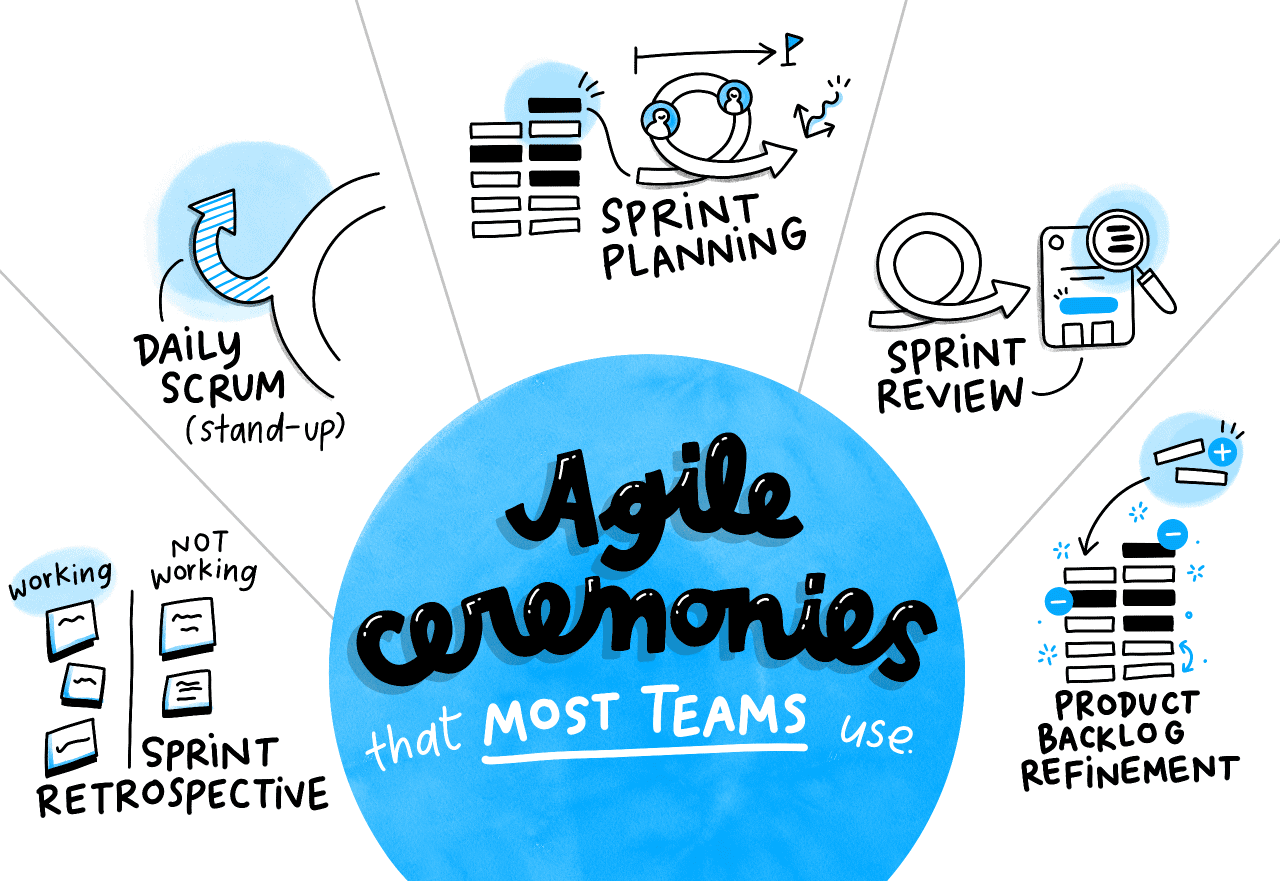Agile Sprint Ceremonies
Running effective sprint ceremonies are crucial for agile teams to consistently align, track progress, and improve. Walk through core agile sprint ceremonies and best practices to help your team collaborate smoothly within sprints.

Sprints and sprint ceremonies are key to agile software development, providing a framework for teams to consistently align, track progress, gather feedback, and improve.
This guide will walk through the core sprint ceremonies used in frameworks like Scrum — sprint planning, standups, reviews, and retrospectives — to help your team collaborate effectively within agile sprints.
Key Takeaways:
- The right cadence is crucial. Sprint ceremonies should occur at a consistent interval to instill a productive rhythm.
- Daily standups keep teams aligned on blockers and progress. Conduct them at the same time and place for maximum turnout.
- Retrospectives drive continuous improvement. Don't skip them! Reflecting on what worked well and what needs adjustment is key.
- Active participation is mandatory. Ceremonies fail when they become spectator sports. Engage everyone.
What is a Sprint?
A sprint is a set period of time (usually 1-4 weeks) where the team works to complete a set of user stories or backlog items.
Key aspects of a sprint include:
- Timeboxed to keep sprints short and focused (often 1-4 weeks long)
- Has a pre-defined start and end date
- Scope is defined by selecting user stories from the product backlog to complete in the sprint
- Results in a potentially shippable product increment
- Provides a regular cadence to develop, deliver, and gather feedback
The goal of a sprint is to build and deliver working software quickly. At the end of each sprint, the team should have an integrated increment of the product that could theoretically be released, although it may not be released to production after every sprint.
The consistent sprint cadence enables agile teams to learn and fine-tune their development practices over time. Short iterations allow the team to adapt to changes quickly. Regular delivery of working software enables earlier user feedback.
Overall, sprints provide a framework for agile teams to frequently align, inspect progress, and adapt in order to develop products quickly and efficiently.
Here is the section on The Sprint Ceremonies in Markdown:
The Sprint Ceremonies
Certain recurring meetings/ceremonies are held throughout each sprint to plan, track, and review progress. These ceremonies provide a framework for the team to consistently align, inspect progress, and adapt as needed throughout the sprint.
This guide will cover the key sprint ceremonies:
- Product Backlog Refinement
- Sprint Planning
- Daily Standups
- Sprint Review
- Sprint Retrospective
The consistent use of these structured ceremonies enables effective collaboration, communication, and continuous improvement during agile sprints. They provide regular opportunities for the team to come together, ensure shared understanding, surface obstacles, and align on solutions to continue marching toward the product goal.
Adopting consistent sprint ceremonies can help establish team rituals, enable transparency, and create focus around delivering value in every sprint. Let's explore the purpose and best practices for each main ceremony.
Here is a markdown formatted section on product backlog refinement for your agile guide:
Refinement
The product backlog refinement, also known as backlog grooming, is a regular event where the product owner and the development team review and revise the product backlog to ensure it is ready for upcoming sprints.
Purpose
The main goals of product backlog refinement are:
- Ensure the product backlog contains the appropriate items that need to be prioritized and completed. This includes adding, removing, and revising backlog items.
- Provide details and estimates for the top items in the backlog that will be tackled in upcoming sprints. The development team works with the product owner to split large items into smaller stories and provide estimates.
- Gain a shared understanding of the upcoming work and sprint goals between the product owner and development team.
Attendees
The product backlog refinement is attended by:
- Product owner
- Development team members
- Scrum master (optional)
Activities
Typical activities that occur during backlog refinement include:
- The product owner presents new backlog items for the team to discuss.
- The development team asks questions of the product owner to gain clarity on new items.
- The team estimates effort for new items in the backlog using planning poker or other techniques.
- The team decomposes large or complex items into smaller, more manageable stories.
- The team revises and re-prioritizes items in the backlog as needed.
- Lower priority items may be removed from the backlog.
- The latest product increment and feedback is reviewed.
Upcoming sprint goals are discussed at a high level.
Outcomes
The product backlog refinement meeting should produce:
- A groomed product backlog containing properly sized and prioritized items ready for the next sprint.
- Estimates and clarification for top backlog items so the team is prepared to begin work immediately in the next sprint.
- An shared understanding of upcoming backlog items and sprint goals.
The refined product backlog is a key input for sprint planning. The team should leave the refinement with enough clarity and information to be able to successfully commit to sprint deliverables.
Sprint Planning Meeting
The sprint planning meeting is held at the start of each sprint to define the sprint goal and select user stories from the product backlog to work on.
Key aspects of sprint planning include:
- Timeboxed meeting, typically 2-4 hours for a 1-2 week sprint
- Entire team participates
- Product owner presents prioritized stories from backlog
- Team asks questions to clarify details on stories
- Team selects stories they can commit to completing in the sprint
- Team and product owner agree on sprint goal
The outcomes of sprint planning include:
- Sprint goal - This is the overall objective to keep the team focused on delivering value related to a central theme.
- Committed user stories - These are the specific backlog items the team agrees to work on in the upcoming sprint.
Effective sprint planning sets the entire team up for success in the sprint by ensuring everyone understands the why and what to be accomplished in the coming iteration.
Daily Standup Meeting
The daily standup meeting is a short, timeboxed status meeting, typically held in the morning. Key aspects of daily standups include:
- Timeboxed to 15 minutes or less
- Held at the same time and place each day of the sprint
- All team members participate
- Often conducted standing up to keep it short
Each team member shares:
- What they completed yesterday
- What they plan to work on today
- Any blockers or impediments
Not a time for detailed problem-solving - discussions are taken offline.
The daily standup enables the team to quickly:
- Share progress and identify obstacles
- Make adjustments and re-plan as needed
- Identify risks or changes that could require adjusting scope
- Sync on blockers and who can help remove them
Keeping standups consistent, focused, and fact-based helps maintain alignment and transparency across the team day-to-day.
Sprint Review Meeting
The sprint review meeting is held at the end of each sprint to review and demonstrate the work completed.
Key aspects of the sprint review:
- Entire team and key stakeholders attend
- Team demonstrates new increment of working software
- Team provides status updates on backlog items worked on
- Stakeholders provide feedback on the work completed
- Feedback is captured to inform planning for next sprint
The review enables stakeholders to evaluate the work and provide feedback early and often. It also provides closure to the sprint and helps the team celebrate wins.
Sprint Retrospective
The sprint retrospective provides dedicated time for the team to reflect on how the sprint went.
Key aspects of the retrospective:
- Facilitated by scrum master
- Timeboxed to 60-90 minutes
- All team members participate openly
Team reflects on:
- What went well that we should continue doing
- What can we improve for the next sprint
- Team agrees on changes to implement in next sprint
Retrospectives enable continuous improvement by embedding time to inspect and adapt into each sprint cadence.
Conclusion
The consistent use of recurring sprint ceremonies such as planning, standups, reviews, and retrospectives provides a framework for agile teams to stay aligned, track progress, and continuously improve.
Taking the time to regularly come together, inspect progress, and adapt processes allows teams to collaborate effectively and deliver value in every sprint. Establishing these team rituals creates focus, transparency, and a regular cadence of learning.
Adopting a consistent set of sprint ceremonies can enable greater agility, alignment, and outcomes for product development teams.
Frequently Asked Questions
How long should our sprints be?
Typical sprint lengths are 1-4 weeks. Shorter sprints of 1-2 weeks enable more frequent inspection and adaptation. Longer sprints around 3-4 weeks allow for more work to be completed in one sprint. Most teams find a 2 week sprint cadence to be optimal.
How much time should we allocate for sprint planning?
Allocate 2-4 hours for sprint planning for a 1-2 week sprint. The meeting is timeboxed and the actual time will vary based on the team size and amount of stories to size and plan.
Does the whole team have to attend the daily standup?
Yes, the daily standup is most effective when all team members attend. This ensures full transparency into blockers and risks that may impact other team members.
Should we demo all completed stories in the sprint review?
No, you don't need to demo every single completed story. Select a representative sample of user stories to demo and provide status updates on the remaining work. The goal is to gather helpful feedback, not to be exhaustive.
How long should a sprint retrospective last?
Retrospectives are typically timeboxed to 60-90 minutes. The meeting should provide enough time for all voices to be heard when reflecting on the sprint.

